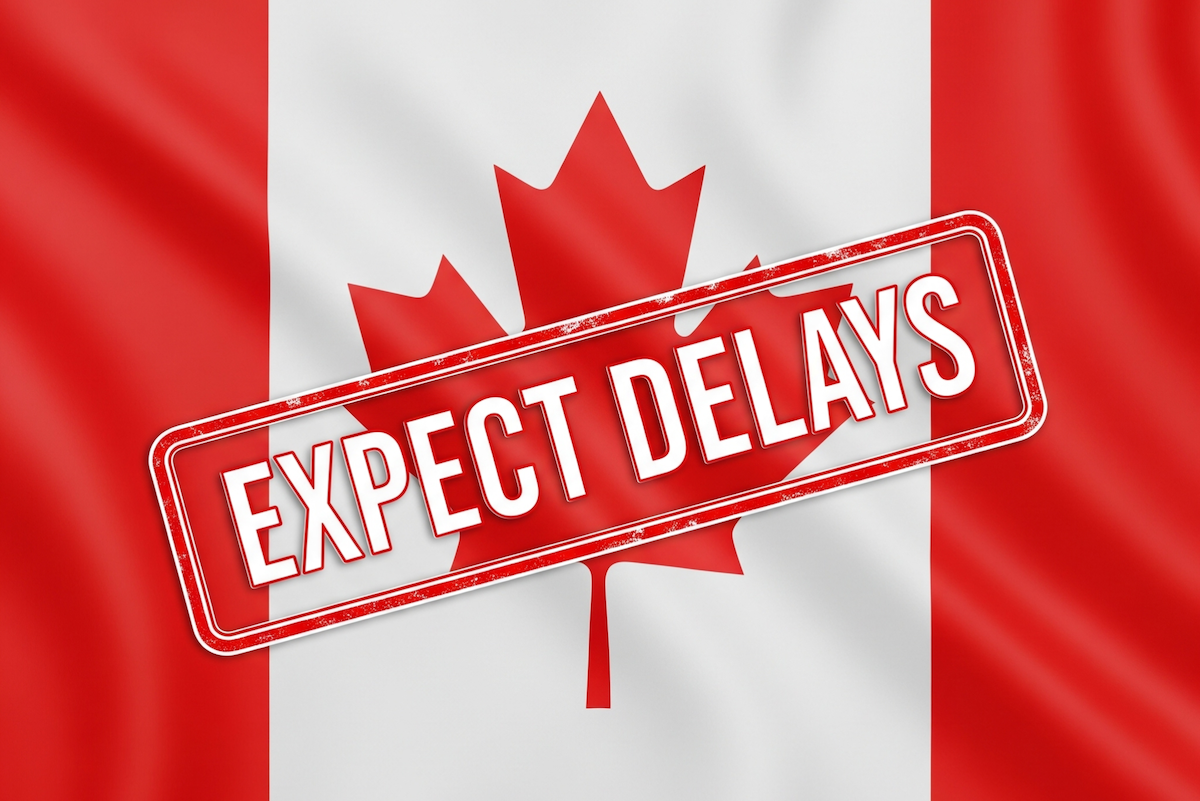Last Updated On 27 June 2025, 9:32 AM EDT (Toronto Time)
New IRCC Update: In mid-2025, Canada’s immigration system is facing a critical challenge: a backlog of 802,000 applications for citizenship, permanent residency, and temporary residency, as reported by Immigration, Refugees and Citizenship Canada (IRCC) on June 26, 2025
According to the latest IRCC data, a staggering 2,117,800 applications are currently in process, with 802,000 exceeding IRCC’s service standards.
This article dives deep into the numbers, explores the implications for applicants, and analyzes the broader impact on Canada’s immigration landscape.
With detailed insights, data tables, and a focus on the human stories behind the statistics, this piece aims to shed light on a critical issue affecting millions.
Table of Contents
Canada’s immigration system is a cornerstone of the nation’s growth, welcoming newcomers who contribute to its economy, culture, and diversity.
However, the mounting backlog of applications has raised concerns about the system’s efficiency and its ability to meet the needs of applicants in a timely manner.
IRCC’s service standards aim to process 80% of applications within specific timeframes, but the latest data reveals significant challenges in achieving this target, particularly for permanent and temporary residency applications.
The total inventory of 2,117,800 applications includes:
- Citizenship applications: 246,600
- Permanent residence applications: 897,900
- Temporary residence applications: 973,300
Of these, 1,315,800 applications are being processed within service standards, while 802,000 are backlogged, meaning they have exceeded the expected processing times.
This backlog represents 38% of the total inventory, highlighting a systemic issue that affects hundreds of thousands of individuals waiting to start their new lives in Canada.
| Category | Total Applications | Within Service Standards | Backlogged | Backlog Percentage |
|---|---|---|---|---|
| Citizenship | 246,600 | 200,300 | 46,300 | 19% |
| Permanent Residence | 897,900 | 495,500 | 402,400 | 45% |
| Temporary Residence | 973,300 | 620,000 | 353,300 | 36% |
| Total | 2,117,800 | 1,315,800 | 802,000 | 38% |
The backlog’s size is not just a number—it translates into prolonged uncertainty for applicants, delayed family reunifications, and economic impacts for both individuals and the country.
Let’s break down the situation for each application category.
The citizenship application process is one of the final steps for many immigrants seeking to fully integrate into Canadian society.
IRCC reported 246,600 citizenship applications in process, with 200,300 (81%) within service standards and 46,300 (19%) backlogged.
Key Statistics for Citizenship Applications
| Metric | Value |
|---|---|
| Total applications | 246,600 |
| Within service standards | 200,300 |
| Backlogged | 46,300 |
| Percentage within standards | 81% |
| New citizens (April 1–May 31) | 42,800 |
The 81% processing rate within service standards meets IRCC’s 80% target, indicating relative stability in this stream.
However, the 46,300 backlogged applications still represent tens of thousands of individuals facing delays in achieving citizenship.
These delays can affect access to benefits like voting rights, international travel with a Canadian passport, and a sense of full belonging in Canada.
For example, consider a family who has lived in Canada for years, contributing to their community and economy, only to wait indefinitely for their citizenship approval.
Such delays can lead to frustration and a sense of disconnection, particularly for those who have already met residency requirements.
Permanent residence (PR) applications are critical for individuals seeking to establish long-term roots in Canada.
IRCC is processing 897,900 PR applications, with 495,500 (55%) within service standards and 402,400 (45%) backlogged.
This is the largest backlog among the three categories, both in absolute numbers and as a percentage.
Key Statistics for Permanent Residence Applications
| Metric | Value |
|---|---|
| Total applications | 897,900 |
| Within service standards | 495,500 |
| Backlogged | 402,400 |
| Percentage within standards | 55% |
| Decisions made (Jan 1–May 31) | 193,000 |
| New permanent residents welcomed | 168,550 |
The 55% processing rate within service standards falls far short of IRCC’s 80% target, signalling significant inefficiencies.
With 402,400 applications backlogged, hundreds of thousands of applicants are left in limbo, facing delays that can stretch months or even years beyond expected timelines.
The large inventory of PR applications suggests that Canada has enough applications to meet its immigration targets for the next two years.
However, the backlog undermines the system’s ability to deliver timely outcomes, potentially deterring skilled workers, families, and refugees who are essential to Canada’s economic and social fabric.
For instance, economic immigrants in programs like Express Entry may face delays that disrupt career plans, while family sponsorship applicants endure prolonged separations from loved ones.
Temporary residence applications, which include study permits, work permits, and visitor visas, form the largest portion of IRCC’s inventory at 973,300.
Of these, 620,000 (64%) are within service standards, while 353,300 (36%) are backlogged.
Key Statistics for Temporary Residence Applications
| Metric | Value |
|---|---|
| Total applications | 973,300 |
| Within service standards | 620,000 |
| Backlogged | 353,300 |
| Percentage within standards | 64% |
| Study permits finalized (Jan 1–May 31) | 227,800 |
| Work permits finalized (Jan 1–May 31) | 591,200 |
The 64% processing rate within service standards is well below the 80% target, reflecting challenges in handling the high volume of temporary residence applications.
The backlog of 353,300 applications affects international students, workers, and visitors, many of whom face significant disruptions to their plans.
For example, international students awaiting study permit decisions may miss academic deadlines, while temporary workers may lose job opportunities due to delayed work permits.
The ripple effects of these delays extend to Canadian institutions and employers, who rely on international talent to fill gaps in the labour market and education sector.
Several factors contribute to the growing backlog in Canada’s immigration system:
- High Application Volumes: Canada’s reputation as a welcoming destination has led to a surge in applications, particularly for permanent and temporary residency. The 973,300 temporary residence applications alone reflect the immense demand.
- Resource Constraints: Processing delays suggest that IRCC may lack the staff, technology, or funding to handle the volume of applications efficiently.
- Complex Application Requirements: Certain streams, such as family sponsorship or refugee programs, involve extensive documentation and verification, which can slow down processing.
- Global Disruptions: Residual effects from the COVID-19 pandemic, geopolitical conflicts, and economic shifts have increased application backlogs worldwide, including in Canada.
While IRCC has made progress in some areas, such as welcoming 42,800 new citizens and 168,550 new permanent residents in 2025, the overall backlog remains a significant hurdle.
For those caught in the backlog, the wait can feel endless. Here are some practical steps applicants can take:
- Check Application Status Regularly: Use IRCC’s online portal to monitor updates and ensure all requested documents are submitted.
- Seek Legal Advice: Immigration consultants or lawyers can provide guidance on complex cases or delays.
- Stay Informed: Follow IRCC announcements for policy changes or updates on processing times.
- Explore Alternatives: For temporary residents, consider other visa options or pathways if delays persist.
Canada’s immigration system is under strain, with 802,000 applications backlogged across citizenship, permanent residence, and temporary residence streams.
While the citizenship stream meets IRCC’s service standards, the permanent and temporary residence categories lag significantly, with only 55% and 64% of applications processed on time, respectively.
This backlog affects hundreds of thousands of individuals, from students and workers to families and refugees, creating uncertainty and delaying dreams.
The data paints a clear picture: Canada’s immigration system is struggling to keep pace with demand.
Addressing this crisis requires urgent action to ensure the system can deliver on its promise of opportunity and inclusion.
For now, applicants and stakeholders alike are left hoping for change, as the backlog continues to cast a shadow over Canada’s immigration future.
What is the current size of Canada’s immigration backlog in 2025?
As of May 31, 2025, IRCC was processing 2,117,800 applications, with 802,000 (38%) backlogged, exceeding service standards.
How many citizenship applications are delayed?
Of 246,600 citizenship applications, 46,300 (19%) are backlogged, while 81% meet service standards.
Why is the permanent residence backlog so large?
With 897,900 applications, 402,400 (45%) are backlogged due to high demand and processing inefficiencies, missing the 80% service standard target.
How are temporary residence applications affected?
Of 973,300 temporary residence applications, 353,300 (36%) are backlogged, with only 64% processed within service standards.
What are Canada’s immigration targets for 2025-2027?
Canada aims to welcome 395,000 permanent residents in 2025, 380,000 in 2026, and 365,000 in 2027, per the 2025-2027 Immigration Levels Plan.
You may also like: 5 New CRA Benefit Payments Coming In July With An Increase
New GST Payment Increase In Canada Effective July 2025
New Canada CDB Payment Of Up To $200 Starting In July 2025
New CPP Payments to Be Sent Canada-Wide on June 26


